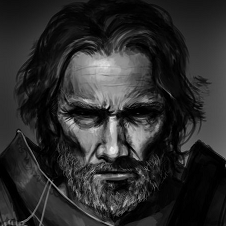-
Posts
38,424 -
Joined
-
Last visited
Content Type
Profiles
Forums
Events
Gallery
Everything posted by Ace-Garageguy
-

what is "good design"?
Ace-Garageguy replied to southpier's topic in General Automotive Talk (Trucks and Cars)
Multiple cans of worms here. I don't know of a brief, concise definition of "good design" as it applies to cars, but I know it if I see it. Things like proportion, interaction of elements of surface, volume and line, a coherent theme...all play a part. Functionality is important too. Something beautiful but useless has limited appeal. Also, much of "good design" is subjective, and skills develop over time. I look back at some of my own early work and think "that's awful" and instantly see things that could have been improved to make more pleasing shapes. Good design rarely comes from the first attempt on anything, either. Designs take tuning to look their best, committees don't do it well (usually) and there needs to be a willingness to be VERY critical of one's own design work to get visually appealing results consistently. I agree with you regarding the slight forward-lean of the grille-shells on most '32 Ford builds, real or in scale, and I usually change it on my own work. The "leading with the tires" look is somewhat due to the location of the front axle relative to the body / frame, and without major work, you're kinda stuck with it (removing the frame horns as in Mr.Red just accentuates it). Pushing the radiator-shell too far forward (blue car below) makes a goofy-looking car, appearing to be about to trip on its own tongue, and seriously unbalancing the proportions. I don't particularly like the rooflines on either of your reference cars above either. The sharp angle and upward slope at the rear of the soft-top is jarring to me, and the rear of the top on the red car is also too high in my eyes. The DuVall-style windshields are usually bought, not designed for a specific car, and the builders often just go with what they get. The look can be tuned to be more attractive, but it's time and money to get there. The windshield on this car doesn't have as much too-wide-up-top as your examples, but this one was most likely made specifically for the car. Here's a '32 with what I find to be a much more pleasing hard-top line, with the forward-leaning grille corrected as well. The width of the DuVall could be adjusted to good effect though. Very subtle changes work miracles. Here's a more pleasing line for an up-top on a '32...and though it's chopped significantly, the same profile could work on a taller top too. Adding carefully-designed additional bows, while somewhat complicated, can have remarkable results improving the flow of an up-top as well. "Stance", though a seriously overworked term, also has an instant effect on the initial perception of a car as being well-proportioned or not. Adjustments of as little as 1/4 inch of ride height, while not obvious to many viewers, can have an almost undefinable but instant impact on a car's look. Formal art and design curriculums exist, obviously, to, at least in part, teach the creation of "pleasing shapes". Art Center College of Design in Pasadena was for a long time THE place to go if you wanted to design in Detroit. Of course, the focus of a design-education is usually more along the lines of "industrial design", developing products hand-in-hand with marketing's perceived needs, and the blend isn't always successful. Here's an article from a January 2009 NY Times on just this topic. http://dealbook.nytimes.com/2009/01/31/defining-good-or-bad-design/?_r=0 Here's a design-by-committee, obviously, looking like it was designed by folks who had never seen a good-looking car, and had no idea of what that might be. "Good design"? No, but designed by "professionals" who get paid well enough to do better than this. It's entirely without harmony or theme, and every line, curve, surface and volume seems to have been mindlessly stuck-on by someone who hadn't seen the rest of the team's work. -

shortened '50 Chevy pickup
Ace-Garageguy replied to crazyjim's topic in Model Trucks: Pickups, Vans, SUVs, Light Commercial
Beautiful color and paint work. Like the shortening idea and the interior update too. Cool little truck. -
More pix at http://s18.photobucket.com/user/PPiira/library/JPS/
-
-
Reworked the helmet fairing, lower, more rounded in back. Also fitted the headers this side, cut the hood for them, and relocated the front 4-link to clear. Pretty tight up in front, but everything would clear enough to work. Reworked the nose profile and curvature as well. Maybe not much different to some eyes, but much, much better to mine. EDIT: But now I see a little bump in the curve that crept in due to the different hardnesses of the plastic and the bondo. Gotta fix that. Man, these big photos really show stuff it's easy to miss otherwise.
-
[url=http://s1019.photobucket.com/user/fastoldcarz/media/Not%20my%20dogs/MARCH%2025%202015%20053_zpsaqxjvewk.jpg.html][/uR The ERA Cobra and GT-40 replicas are among the most-accurate-appearing of all the kits. The ERA Cobras are slightly spoiled for me because they're on rectangular-tube frames instead of the signature round-tube frames of the real cars. Still, it's pretty hard not to love the looks of this car. I think I'm in love.
-
Really starting to get ass-chapped about some aspects of my current primary business relationship. Maybe time to be movin' on.
-
Years ago when I was a much nicer and helpful fella, I had lots of "friends" who'd let me fix their cars, houses, lawnmowers, bikes, loan them my truck or tools...or money...but it almost always seemed when I needed something, they were "busy that day" or "broke" when I asked to be paid back the money. Now I have 2 or 3 friends who are actually friends, not users. I figure I'm lucky to have even that many.
-
Like it. That rear 3/4 view is especially wicked.
-
Sorry about your friend, Carl. It sounds that, especially during all the crapp he had to go through over the years, he was lucky to have had a good friend like you.
-

1/25 Revell Ford Del Rio Ranch Wagon 2'n'1
Ace-Garageguy replied to Matt T.'s topic in Car Kit News & Reviews
Ahhh...if only it were indeed that easy. I'd discorporate this very instant. -
Remarkable. And just about the only way to produce a part like this (3D printed). The bumps on the spokes are due to current limitations in the printing process, but this is a very good indication of what's coming in the next couple of years as the technology continues to develop and become more affordable for the mainstream modeler. I have several models that would look much much better with a set of these.
-
I've had to deal with Gecko-tier claims reps who had so little knowledge of vehicle structures, they wouldn't (for example) accept an estimate that included all 4 layers of structural stampings inside a forward door jamb that was punched inwards a foot. Morons. Trained and paid? How can this be? Their mantra was "if I can't see it, I can't accept it"...so either you call the tards back out for supplement after supplement...delaying the repair and using up the insured's rental vehicle time...or you force them to watch as you peel layer after layer of crushed metal off the car. Guess which one I did? I've had claims reps who were so morbidly obese they were physically incapable of bending down to check underbody damage, and again, refused an estimate that contained "something they couldn't see". We were forced, one time, to move an in-process vehicle off the lift and dolly the wreck in question on it, just so a fat fool could "see" the damage. I've had the "good hands" guys try to refuse paying the blown-head-gasket part of a collision claim that resulted from the head-injured owner of the vehicle forgetting to turn the engine off after the radiator was holed in the crash. Is it any wonder I'm completely disgusted with the insurance AND car repair industries? Honestly, only 1 out of ten claims reps I've ever dealt with were actually competent to do the work. Somebody help me understand.
-

1/25 Revell Ford Del Rio Ranch Wagon 2'n'1
Ace-Garageguy replied to Matt T.'s topic in Car Kit News & Reviews
I just love semantic distinctions. Consider these. Scale Model: A scale model is most generally a physical representation of an object, which maintains accurate relationships between all important aspects of the original object. (source Wikipedia) Toy: A toy is an object, often a small representation of something familiar, for children or others to play with; plaything. (source Dictionary.com) -
Or move really close to the interstate and sleep with the windows open. Seriously, I know it sucks. That's why I joke about it. It's been a part of me so long I don't notice it much, very often, unless I think about it. The white-noise machine is a good suggestion though. A friend gave me one that does surf, rain, and a bunch of others. Quite realistic.
-

Suppose there's an IRS under there?
Ace-Garageguy replied to Greg Myers's topic in General Automotive Talk (Trucks and Cars)
Yeah, won't even go in a freakin' straight line. Oops...more soon-to-be-dead-guy's "views"... -
Ah Grasshopper...you have just taken your first step into a far, far larger world than you ever dreamed existed... Or, "Why did the Tom cross the road? To get to the chicken on the other side".
-

1/25 Revell '29 Model A Roadster 2'n'1
Ace-Garageguy replied to mrknowetall's topic in Car Kit News & Reviews
You be the judge. Monogram 1/24 '30 body, chopped, everything else 1/25 Real car... -

1/25 Revell '29 Model A Roadster 2'n'1
Ace-Garageguy replied to mrknowetall's topic in Car Kit News & Reviews
You just have to get the plastic past its "glass transition temperature", Tg, which for styrene is about 100C, or boiling water. The tricky bit is holding it in the correct shape as you heat it, without cooking the meat off your finger bones. I'll do a scratch-built hood tutorial soon. -

1/25 Revell '29 Model A Roadster 2'n'1
Ace-Garageguy replied to mrknowetall's topic in Car Kit News & Reviews
Every time I've looked at swapping Revell Boyd T bodies on to AMT fenders, it's worked fine. I've measured the things and they're really all pretty close. The turd in the Buttera and Buttera-derived kits (the itty bitty '34) is the Ford engine and automatic gearbox. They ARE significantly underscale...which is unnecessary, as a correctly-scaled smallblock Ford 289-302 etc. will fit. It's tight, just as it is shoehorning a little Ford V8 into a real T, but it goes in there. -

1/25 Revell '29 Model A Roadster 2'n'1
Ace-Garageguy replied to mrknowetall's topic in Car Kit News & Reviews
'32 rails under a '26-'27 has been a popular look for quite a while... You can build jus' about anything on '32 rails... -

My first WIP here; '70 Dodge Challenger T/A, Parts
Ace-Garageguy replied to Roadrunner's topic in WIP: Model Cars
Everything looks really good from here. -
Yup. Real silence would be nice. Oh well.
-

Testors Metalizer paints,,have questions.
Ace-Garageguy replied to gtx6970's topic in Model Building Questions and Answers
Cool tip. I see it's time for more experimenting. How many coats of metalizer are you using to allow this?

